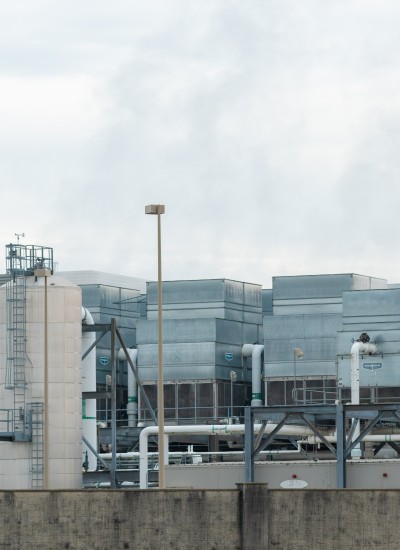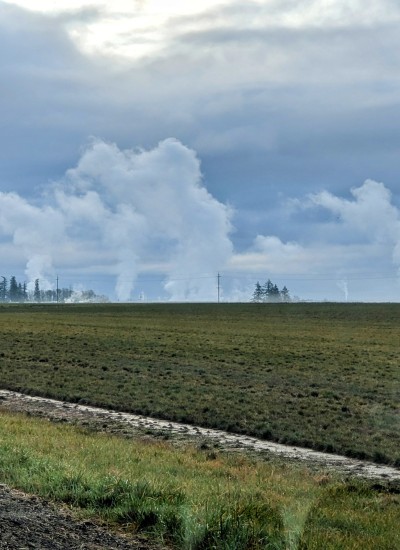By Samuel Diaz | 4-minute read
Imagine you’ve got an excellent job, located in a thriving community, near amenities that make life easier – schools, stores, doctors, parks, activities – and conveniently only a few minutes away from green rolling hills, pristine farmland, and unparalleled natural areas, thanks to smart land use planning.
And yet you’ve chosen not to live there, because the anchor employer in the community pollutes the air so badly that neighbors and employees don’t just say it’s dangerous – the state levies fines against the company.
And now that employer, Intel, a known environmental offender, wants to more than double their current emissions. This is where we step in.

The state of things
Located in Hillsboro at the edge of the Metro urban growth boundary, Intel’s facility is the company’s largest site, employing more than 23,000 people at their Washington County operations alone. In early 2024, Intel announced a plan to invest more than $36 billion in the facility, with $8.5 billion in federal taxpayer dollars coming from the CHIPS and Science Act. The federal funding adds to the $115 million in state taxpayer dollars for Intel’s semiconductor expansions.
Intel is requesting permission from the Oregon Department of Environmental Quality, the state body charged with monitoring Intel’s emissions, to more than double their current carbon emissions at their Washington County campus. Intel seeks to increase their criteria pollutants, including fine particulates, carbon monoxide, and fluorides.
That’s quite a lot of taxpayer money potentially funding dangerous pollution in their community.
1000 Friends of Oregon has called for Intel to use the best – safest – available technology at their campus, make high-efficiency energy and water upgrades, and protect our communities, farms, forests, and watersheds from irreversible harms. In doing so, we’ve partnered with ten other community and environmental groups to bring our concerns directly to DEQ. We want the agency to investigate Intel’s projected emissions, and to more strictly monitor Intel’s emissions and ensure compliance with state law.
Local residents are concerned, weighing in on DEQ’s decision. “An updated Health Risk Assessment should occur prior to the onset of Intel’s proposed doubling of hazardous emissions,” Allen Amabisca and Robert Bailey of Save Helvetia wrote to us in an email. “For Helvetia residents, we have valuable soils, watershed, and crops/forests that run up the Tualatin Mountains. The stronger winds of fall and winter run north toward Helvetia from Intel. Other areas of the Tualatin Valley are targets depending on the facility (Aloha, Hillsboro), the season, the wind direction, and the dispersal radiuses. With good monitoring will come the verification that Tualatin Valley communities need for their sense of health and safety.” Neighbors deserve to be free from corporate greed that negatively affects their health, livelihoods, and safety.

Impact on Oregonians (if left unchecked)
We enjoy a competitive advantage as Oregonians – because of our environmental protections, natural resources, and generous economic incentives for businesses like Intel. And our decision makers should use this advantage to negotiate balanced wins for our economy, environment, and our communities.
1000 Friends of Oregon is working on the ground in partnership with other mission-driven organizations and local residents – researching and pushing for strategies that can improve quality of life for neighbors, meaningfully invest in the community and the environment, and protect other pillars of our economy in Washington County. This research has led us to concerning facts about Intel and the semiconductor industry:
- Intel’s absolute carbon pollution (a.k.a. emissions) is significantly increasing. Recently, Intel reported 1.54 million metric tons in emissions, up 13 percent in two years.
- Global semiconductor industry emissions are expected to double from 2020 to 2030, reaching 183 million metric tons of carbon pollution, according to conservative projections.
- If current growth continues unchecked, carbon pollution from semiconductor production will rise by about 8 percent each year from now until 2045, according to modeling.
Intel’s increase in carbon pollution is happening right here in Oregon, with a guarantee to worsen if their permit is approved.
|
Pollutant |
Current limit | Proposed limit | Percentage change |
|---|---|---|---|
|
Volatile organic compounds |
178 |
351 |
97% |
|
Total particulate matter |
41 |
68 |
66% |
|
Sulfur dioxide |
39 |
36 |
−8% |
|
Nitrogen oxide and nitrogen dioxide |
197 | 413 | 110% |
|
Greenhouse gasses |
819,000 | 1,722,804 | 110% |
|
Fluorides |
6 | 12 | 91% |
|
Carbon monoxide |
229 | 598 | 161% |
Health, safety, and livability first
In 2023, Governor Kotek signed Senate Bill 4 into law, creating one-time executive authority to unilaterally expand urban growth boundaries – tearing a big loophole into our public, data-driven processes for urban expansion. The loophole raises a lot of questions about the protections for the livelihoods and the health of nearby farmers, farmworkers, and those who work outdoors on construction projects. While 1000 Friends of Oregon negotiated safeguards into SB 4, corporate interests and the politicians who sided with them skipped over a major fact: 10,000 acres of industrially zoned land, made up of sites of all sizes, already sit within our existing urban growth boundaries, a big reason the governor’s executive authority hasn’t been used.
Existing land use laws guide economic development, offering us a strong footing to build high-quality jobs, a healthy environment, and thriving communities. If Intel’s permit is unchecked and approved, other businesses within Washington County would face a tough, almost impossible, time getting their own permission to emit in the airshed without violating Clean Air Act regulations – let alone avoid violating land use planning Goal 6, which calls for local governments to make plans that protect air, water, and land resources from pollution.
Our land use planning goals only work if they are strengthened, resourced, and enhanced by decision makers. We won’t give up on this fight, for our neighbors and stewards of our lands living near Intel and for communities across Oregon who could face similar corporate attempts to pollute with abandon.
Read the full letter that 1000 Friends, our local affiliate Save Helvetia, and other mission-based organizations signed and sent to the Department of Environmental Quality earlier this year, and consider joining us as a donor this Earth Month to support essential program work like this.
You may have noticed that 1000 Friends of Oregon is not participating in this year’s official Earth Day Oregon campaign. That decision came after learning that Intel would be the lead sponsor for the campaign. At this time, while we cannot participate in a campaign being funded by Intel, we continue to applaud and support the good work of all the nonprofits that are part of that campaign. You can directly support 1000 Friends of Oregon this Earth Month and always at friends.org/donate.
